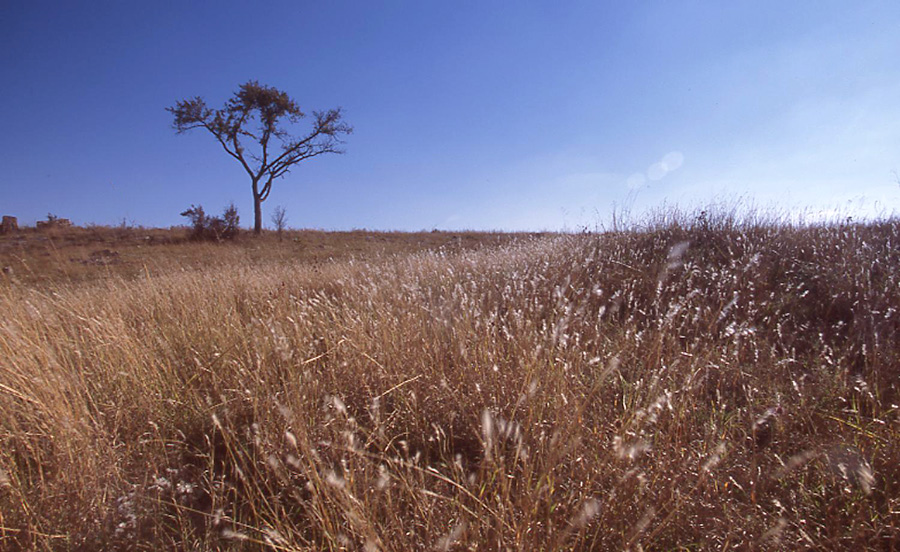FLORA.
The distribution of Oklahoma vegetation shows a pronounced east-to-west dispersal. For example, in eastern Oklahoma there are extensive forested areas, particularly in the Ozark Highlands and Ouachita Mountains, where oak-hickory-pine and oak-hickory forests are common. In central Oklahoma oak-hickory forests and woodlands of the Cross Timbers form a transition with the prairies. Grasslands follow a similar pattern, with tallgrass prairie in eastern and central Oklahoma, mixed-grass prairie in the west, and shortgrass prairie in the Panhandle. A number of woody vegetation types occur in the mixed-grass prairie, such as sandsage shrublands and shinnery oak on deep sand deposits, mesquite grasslands, and redberry juniper woodlands. In the northwest corner of Cimarron County the easternmost extent of Rocky Mountains front-range vegetation occurs, and it is characterized by pinyon pine and one-seed juniper woodlands.
The pattern of vegetation distribution in Oklahoma is a product of precipitation and surface geology. For example, annual rainfall is greatest in the forested regions of the east and lowest in the grasslands of the west. Likewise, surface geology affects the soil development and vegetation of an area; for example, limestone produces clay soils. In the Arbuckle Mountains, where limestone is abundant, black dalea, shortlobe oak, and Ashe juniper flourish. Salt-tolerant species such as redberry juniper and mesquite are abundant in the gypsum hills of western Oklahoma. Fire is also an important ecological force for reducing woody plant cover and maintaining open grasslands. Much of the increase in red cedar is due to the suppression of fire by land management practices.
The state's range of vegetation includes approximately twenty-five hundred plant species. The grass, sunflower, and legume families account for the greatest number of these. Little bluestem, big bluestem, Indian grass, switchgrass, and side oats grama are the most commonly encountered grasses. In fact, they can be found in every county. Common members of the sunflower family include their namesakes, asters, bitterweed, broomweed, Barbara's button, ragweeds, and goldenrods. The legume family includes several shrubby plants, such as leadplant, but the majority of species are herbaceous. Vetch, locoweed, scurf pea, and the prairie clovers are prominent members of this family. Oaks are the most common family of trees and include post oak and blackjack abundant oaks, with ranges extending from eastern into western Oklahoma. The elms and hickories are also important tree families.
There are several unique occurrences of plants in Oklahoma. For example, seaside alder, a common shrub along stream banks and cobble bars, is found only in the Blue River basin of Oklahoma and in Delaware and northern Georgia. In Caddo and Comanche counties there are sugar maples in isolated canyons, a considerable distance from the main population in eastern Oklahoma. Plateau live oaks in the Quartz and Wichita mountains are trees common on the Edwards Plateau of Texas. Only two species of plants, the eastern and western prairie fringed orchid, are federally listed as threatened. However, neither species has been found in Oklahoma for several decades.
See Also
BIRDS, CLIMATE, ENVIRONMENT AND CULTURAL ECOLOGY, FORESTRY, HUNTING, MAMMALS, REPTILES AND AMPHIBIANS
Learn More
William E. Bruner, "The Vegetation of Oklahoma," Ecological Monographs 1 (1931).
Bruce Hoagland, "Vegetation," in Charles R. Goins and Danney Goble, Historical Atlas of Oklahoma (4th ed; Norman: University of Oklahoma Press, 2006).
Bruce Hoagland, "The Vegetation of Oklahoma: A Classification for Landscape Mapping and Conservation Planning," Southwestern Naturalist 45 (2000).
Constance Taylor and John Taylor, An Annotated List of the Ferns, Fern Allies, Gymnosperms, and Flowering Plants of Oklahoma (Durant, Okla.: Biology Department Herbarium, Southeastern Oklahoma State University, 1994).
Citation
The following (as per The Chicago Manual of Style, 17th edition) is the preferred citation for articles:
Bruce Hoagland, “Flora,” The Encyclopedia of Oklahoma History and Culture, https://www.okhistory.org/publications/enc/entry?entry=FL003.
Published January 15, 2010
Last updated August 8, 2018
© Oklahoma Historical Society


